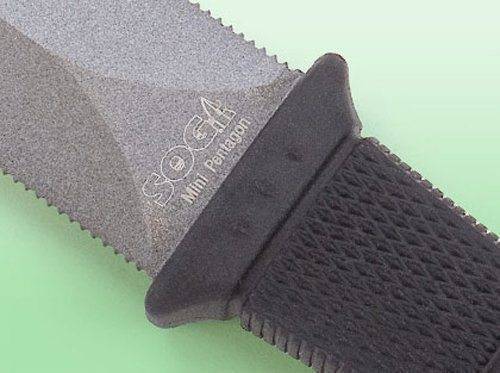Survival and Outdoors
A Comprehensive Guide to Boot Knives: My 3 Favorites
07.04.2016
The term “boot knife” comes from a time in American history where violence was not uncommon and thus, a person often needed to defend himself from aggressors. However, the firearms of the time were often far less than reliable and, due to the poor state of metallurgy back then, they were sometimes prone to explode in the shooter’s hand! Therefore, because the men of the time wore straight legged pants and leather boots with stovepipe uppers, the inside of one’s boot was a convenient place to carry a concealed “boot knife”. Therefore, the “boot knife” is, by definition, a purpose specific fighting knife and thus, they generally featured either a double edged blade with a saber grind or a clip point blade with either a flat grind or a hollow grind and double quillions. Consequently, these are still the most popular boot knife blade designs today because they are capable of both slashing and stabbing efficiently. However, in addition to the correct blade design and correct blade steel, a good boot knife must also have a strong tang and an ergonomic handle design along with a positive, non-slip, grip. Fortunately, modern technology has blessed bladesmiths with a wide range of blade steels and handle materials that fit the bill and they have taken advantage of them to produce some excellent boot knives.
What To Look For When Choosing a Boot Knife

Because a Boot Knife is most often chosen by people who require a relatively small, purpose specific, easily concealable, fighting knife, there are five key features that a person should look for when considering the purchase of a boot knife consisting of the size of the knife, the design of the blade, the type of steel from which the blade is constructed, the construction of the tang, and the design of, and the material from which, the handle is made:
1. Concealability – when choosing a boot knife, most professionals tend to prefer a knife with a blade that measures 3 inches to 4 inches in length so that the knife is easy to conceal and yet, is also long enough to penetrate a person’s body cavity and reach their vitals. However, others prefer knives with 5 to 6 inch blades because, even though they more difficult to conceal, they have both more reach and more weight.
2. Blade design – most boot knives feature either a double edged blade with a spear point or a single edged blade with a clip point because both designs work well for slashing as well as piercing. In fact, either blade design can be constructed to incorporate a shallow belly which optimizes the point for stabbing or, to incorporate a deep belly which optimizes the tip for slashing. But, it should be noted that even so, the double edged blade design is primarily designed for stabbing whereas, the clip point blade design is primarily designed for slashing. In addition, the double edged blade design most often has a flat saber grind as opposed to a flat grind or a hollow grind and thus, double edged daggers with flat saber grinds cannot be honed as sharp as a clip point blade with either a flat grind or a hollow grind. However, the exception to this rule is a double edged blade with a hollow saber grind.

3. Blade steel – because boot knives are fighting knives by nature, their blades need to be hard enough to hold an edge well and yet, they also need to be tough enough to withstand any lateral forces (bending) that the blade might experience when the tip strikes bone during a thrust or when an assailant twists during a fall. Therefore, it should be noted that while stainless steels are well known for their edge holding abilities, they are not particularly tough steels whereas, the opposite is true of high carbon tool steels in that while they are tough steels, they are not particularly well known for their edge holding capabilities. However, there are certain blade steels that do represent a good compromise between these two qualities and thus, some popular high carbon tools steels for constructing boot knives are A2 and O1 whereas, some popular stainless steels for constructing boot knives are 8Cr13MoV, AUS-8, 440C, ATS-34, and 154 CM. Last, it should be noted that most manufactures list the hardness of their blades after heat treating using a scale known as the Rockwell Hardness C Scale (designated HRC) and thus, tough blade steels generally have a Rockwell Hardness ranging from 51-54 HRC whereas, hard blade steels generally have Rockwell Hardness ranging from 56-62 HRC.
4. Construction – because boot knives are purpose specific fighting knives, it should be noted that the point where the handle or bolster stops and the blade begins is the weakest part of the knife. Consequently, the manner in which the tang (the portion of the knife where the handle is attached) is constructed is of great importance when choosing a boot knife. Therefore, you should know that although there are several different tang designs, the ones best suited for use on boot knives are Full Tangs and Hidden Tangs and each is defined differently. For instance, a Full Tang is a tang that extends the full length of the handle as well as the full width and thus, it is the strongest of the three types of knife tangs. Whereas, a Hidden Tang is somewhat more narrow than a Full Tang and extends nearly the full length but less than the full width of the handle so that the handle can be slid over the tang and secured with either epoxy or pins or both and thus, it is not quite as strong as a Full Tang. However, the Partial Tang is significantly more narrow than a Hidden Tang and, is also noticeably shorter and thus, it is significantly weaker than either a Full Tang or a Hidden Tang and thus, boot knives with Partial Tangs should be avoided.
5. Handle Design and Handle Material – although you might not think so at first, both handle design and handle material are important factors to consider when choosing a boot knife. For instance, the tang should be designed in such as way that it is strong and the handle should be designed in such a way that it is ergonomic and has a positive grip that enables you to retain control over both the edge and the tip of the knife. Therefore, boot knives with full tangs or hidden tangs are best because they are the strongest. Also, the handle material should be both tough and slip resistant and thus, some popular materials for making boot knife handles are linen Micarta, canvas Micarta, G10, Zytel, Hypalon, and Krayton.
A Closer Look at My Favorite Boot Knives
1. Browning Black Label Boot Dagger

A beautiful knife from a top manufacturer, the Browning Black Label features an overall length of 8 1/2″ inches with a double edged blade measuring 4” in length and is constructed using 154 CM stainless steel with a hollow saber grind and a rockwell hardness of 58 HRC. In addition, it features full tang construction with a wasp wasted handle design and G10 handle scales with double dished stainless steel bolsters and an exposed, pointed, pommel for striking. Last, it includes a molded, Kydex, sheath that enables the knife to be carried in almost any position.
2. CRKT/M.J. Lerch Synergist Boot Dagger

A very well designed knife from a well known manufacture with a reputation for quality, the Columbia River Knife & Tool Synergist redesigned by M.J. Lerch features an overall length of 7 5/8″ inches with a double edged blade with a spear point measuring 3 3/8” in length and is constructed using 0.16”, 8Cr13MoV, stainless steel with a hollow saber grind and a rockwell hardness of 56-58. In addition, it features full tang construction with a very ergonomic handle with G10 handle scales. Last, it includes a heavy-duty leather sheath with a heavy-duty clip.
3. SOG Mini Pentagon Boot Dagger

A great little knife from a company known for high quality production knives, the SOG Mini Pentagon boot dagger features an overall length of 8″ inches with a 3 3/8” inch double edged blade with a flat saber grind featuring one plain edge and one serrated edge made from AUS-8 stainless steel with a rockwell hardness of 57-58. In addition, it features hidden tang construction with an ergonomic, finely checkered, textured Krayton rubber handle. Last, it includes a Kydex sheath with Tek-Lok.
Conclusion: It’s Your Turn To Choose
So, as you can see, there is actually quite a bit to consider when purchasing a boot knife because the blade needs to have the ability to take and hold a fine edge and both the tang and the blade need to be strong enough withstand the impact generated when striking bone as well as the lateral forces generated when an assailant’s body twists. Plus, it is helpful if the handle has an ergonomic shape and a positive grip that enables you retain the knife even when the grip is wet. Therefore, you should carefully consider all of the factors such as concealability, blade design, blade steel, tang construction, and handle design when choosing a boot knife.









